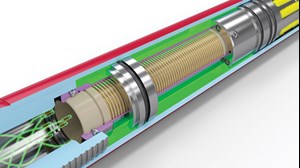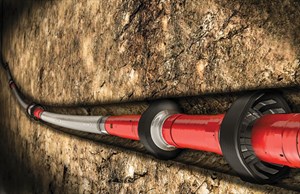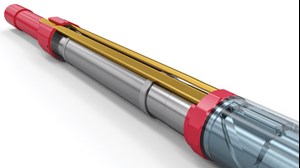Innovation leads to step-change in well completion efficiency
In today’s market, operators demand optimal production over an extended productive lifecycle to achieve the lowest cost per barrel. This demand has led to the development of more complex reservoirs in: 1) more remote locations; 2) at greater depths, including deep and ultra-deepwater; 3) at higher deviations; and 4) longer laterals and open holes for increased reservoir contact.
Despite the complexity of today’s completions, operators still want to get wells to production faster. Service providers, in turn, are looking to shorten time to production by reducing installation times, eliminating the need for intervention and workovers, and limiting nonproductive time (NPT)—all with the objective of lowering CAPEX and OPEX, and ultimately reducing total cost/bbl.
Regular advancements in completion technologies play a critical role in achieving these objectives. With each trip downhole costing potentially millions of dollars, the capability of new technologies to minimize trips downhole and improve the efficiency has a significant impact on overall well-development costs. The best technological advancements not only reduce time to completion, but also deliver high-rate, sand-free production for the life of the well.
SAND-CONTROL TECHNOLOGIES
Weatherford has introduced several new sand-control technologies that overcome many of the challenges operators face while simplifying operations, enhancing reliability, saving time, and reducing CAPEX and the total cost of ownership—even in the most demanding operating environments. These technologies have been developed in this decade to address operators’ challenges, using the latest designs. Some are characterized as major breakthroughs, some as fine tuning of pre-existing engineering designs, and others a result of rethinking the desired outcome. Most were developed with close collaboration between the supplier and operator.
TR1P single-trip completion systems. For an operator to lower its total cost of ownership, we must rethink how to drill and complete wells. Discounting is not a long-term, sustainable strategy to lower the total cost per barrel. The only sustainable way to lower the cost of ownership is to reduce the time that it takes to drill and complete wells.
Weatherford began looking at the cost to complete wells, and how to help operators reduce their total cost of ownership, by looking at the number of trips it takes to complete a well. After analysis, it became evident that two factors had to be satisfied: 1) safely first and foremost; and 2) to provide high flowrates, and sand-free production. A set of criteria was proposed to drive the design of the single trip completion system:
- To ensure complete control of the well, the system must maintain circulation from the rig floor to the toe of the completion at all times.
- Completion equipment must be pressure-insensitive in operation. That is, equipment operates only on command.
- Key equipment must have multi-cycle capability, to provide flexibility in the completion design running, installation and commissioning.

With the three criteria identified, the service provider began to review standard operations to categorize areas to reduce completion time. Normally, in a deepwater operation, up to three trips are required to complete the well. The first trip consists of the sand face completion. This includes the screen, wash pipe inside to allow circulation to the toe, a ball valve for pressure control, and a sand control packer. The second trip, if required, is an intermediate completion run to install a V0-rated packer, to provide a deep-set barrier for tree installation later in the completion program. The third, and final trip, is to run the upper completion with a safety valve. Based on this, it was obvious that combining all three trips into a single trip would be advantageous, if we could continue to meet the criteria set forth above.
Weatherford looked to its RFID technology to be the basis for the single trip system. RFID had been deployed successfully in many different applications, including upper and lower completion systems, but never together. The challenge was to combine what had already proven successful separately, into a cohesive single-trip design. The initiative was successful and produced the TR1P system, Fig. 1.
Multi-zone, open-hole, gravel pack systems. Weatherford has created the first “V0”-rated, multi-zone, open-hole gravel pack system. Its unique capabilities include single-trip, single-position, multi-zone, open-hole, horizontal, gravel pack system (WFX0). It is the only gravel pack system designed from the ground up this decade, and it is engineered specifically to utilize a shunted gravel pack screen and Terraform SZE cup seal packers, to provide true cased-hole functionality in a demanding open-hole environment, all in a single trip.
With a modular design that can be customized to suit unique needs, the WFX0 system leverages many advanced completion technologies to accomplish reliable, gas-tight reservoir isolation. The system combines three core elements—the WFX0 gravel-pack packer, closing sleeve, and quick connect, all of which have earned a V0 gas-tight rating. The same system can be utilized across multiple wellbore sizes and pressure regimes, to improve consistency and installation efficiency.
The service tool incorporated over two decades of lessons learned into the single-tool system. A pressure-balanced setting tool with a segmented ball seat ensures that the packer will not set during circulating operations. The setting tool and packer was designed and tested beyond 15 bbl/min. without the packer setting. The reverse-out flapper, which allows the gravel pack slurry to be reversed out while protecting the reservoir from the circulating pressures, is multi-acting between open and closed positions.
The crossover tool allows for beneficial fluid placement through all operations. Fluid is pumped through the tool and out the wash-down shoe before packer setting operations. This enables us to circulate out the bottom of the completion equipment to aid in getting to bottom. Once the packer is set, the tool then allows top-down circulation to aid in placing an effective gravel pack. After the gravel pack, the tool can then be reconfigured to once again allow circulation out the bottom of the wash pipe, to allow filter cake clean-up chemicals to be placed across the interval.

However, a drawback to openhole gravel packs is the difficulty to isolate different intervals within the reservoir. With the development of the shunt tube screen along the Terraform SZE open-hole cup seal packer, reliable open-hole zonal isolation can now be combined with the dependability of open-hole gravel packing to deliver true multi-zone, open-hole, gravel-packed completions.
Terraform cup seal packers are the only packer that uses a proprietary cup seal isolation technology that actively molds to the changing geometry of the open hole for the life of the well, Fig. 2. The packer system uses up to 24 individual setting mechanisms around the circumference of the packer to ensure a complete elastomer seal to the reservoir face. The multiple setting mechanisms allow advanced expansion capabilities, as well as complete control over the ovality of the wellbore.
Terraform SZE cup seal packers have a shunt bypass within the packer body. They are designed to pass gravel pack slurry from above the packer to below, without any manipulation of the packer or screen assembly. Multiple SZE packers can be run in a single trip without causing any major changes to the gravel pack design. The packers are set by shifting a sleeve within the packer and allowing the hydrostatic pressure within the wellbore to set the packer. Once the packer is set, pumping operations can commence, and operators can gravel pack multiple zones in the wellbore. This allows true cased-hole functionality in open-hole, non-uniform wellbores, across multiple zones.
The Terraform packers, developed initially for open-hole injectors, have set several industry records for in-service reliability. The earliest deployed packers have been installed for 12 years with multiple differential pressure swings, and are still providing 100% zonal isolation. What does this capability deliver to the operator? In a series of open-hole injectors, well construction costs were lowered $250 million. In a multi-zone gravel pack application, those well construction cost-savings will surpass $1 billion. While the term game-changing is often used, few applications are more apt.
GRAVEL PACK SCREEN
An externally shunted, secondary path gravel pack screen was developed to mitigate issues associated with imperfect gravel pack design and placement. Voids and premature bridging, due to insufficient leak off across the connection and handling area of the screen, and significant fluid loss to the reservoir lead to gravel pack failures. To solve this situation, a new leak-off system was designed, using a small, wire-wrapped screen in place of the slotted rectangular tube. The secondary path of the screen system allowed voids within the gravel pack to be packed without the need of interventions or workovers, Fig. 3. This allowed open-hole intervals to be extended to new lengths and gravel-packed, void free.

As intervals continued to extend in length, reservoirs became more challenging, and production rates continued to rise, there became a need for a better screen design. Approximately 20% of a screen joint is used for handling and connection. The previous shunt tube screen had a single, slotted leak-off tube placed across the handling and connection area of the screen to allow the gravel pack slurry to dehydrate, or leak off, across this dead area. Without the leak-off tube across the connection and handling area, there would be no flow path to allow the required slurry dehydration with a proper filter cake in place. Extensive testing showed that the single-slotted leak-off tube across the connection and handling area was not enough to provide adequate dehydration in many cases.
EXPANDABLE SAND SCREEN
When completing a well for water or gas injection into weak or unconsolidated formations, several considerations are important. If sand control measures have not been taken, continuous water injection can cause the open hole to collapse, and subsequent injection shut-downs can result in backflow or crossflow to occur. In addition, efficient maximum uniform outflow is essential to obtaining optimal long-term injectivity and sweep efficiency.
Although expandable sand screen (ESS) technology is not new, it is interesting to document the contrasting performance of ESSs in injector wells over other sand-face completion techniques.With over 100 installations, we are yet to experience a failure in a water injector. Contrast that with stand-alone screen and gravel pack, where the combination of multiple injection shutdowns, water hammer, cross-flow and consequent fines and particle migration, failure (loss of or seriously impaired injectivity) is measured in time, and not percentages. Compliant expansion, a modest pressure load on the formation, evenly distributed, has been demonstrated to mitigate the adverse impact of water hammer and the other phenomena associated with injectors.
Couple this to the well-established ease of installation, flexibility, and improved injection efficiency, compared to other techniques, and the renaissance of ESS technology can be explained more readily.
CONCLUSION
Efficiently accessing reservoirs for exploitation is increasingly complex—and so are the challenges in completing these wells and preparing them for optimal, long-term production. Fortunately, the industry’s understanding of how sand production can be managed, and even eliminated, will avoid losses of control and shutting in wells prematurely. These knowledge gains are reflected in new, highly sophisticated completion technologies, tailored to solve specific application challenges to optimize production. Other new technologies are being developed that will utilize more intelligent completions that better protect the wellbore from sand intrusion, using less human intervention—with the potential for even greater time and cost-savings. WO
- Executive viewpoint (November 2023)
- Downhole tool integrity maximizes completion efficiency and ultimate recovery (July 2023)
- Integrating production expertise with digital capabilities drives next-generation autonomous well control solutions (June 2023)
- Leveraging automation to boost field productivity, enhance operational efficiencies (June 2023)
- Enhancing stimulation efficiency in a fractured open-hole carbonate reservoir by diversion design using advanced modelling techniques (May 2023)
- Automated completion surface system: The path to fracturing 24/7 (May 2023)


